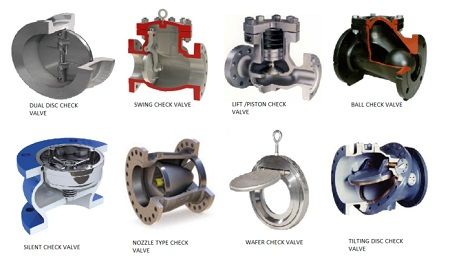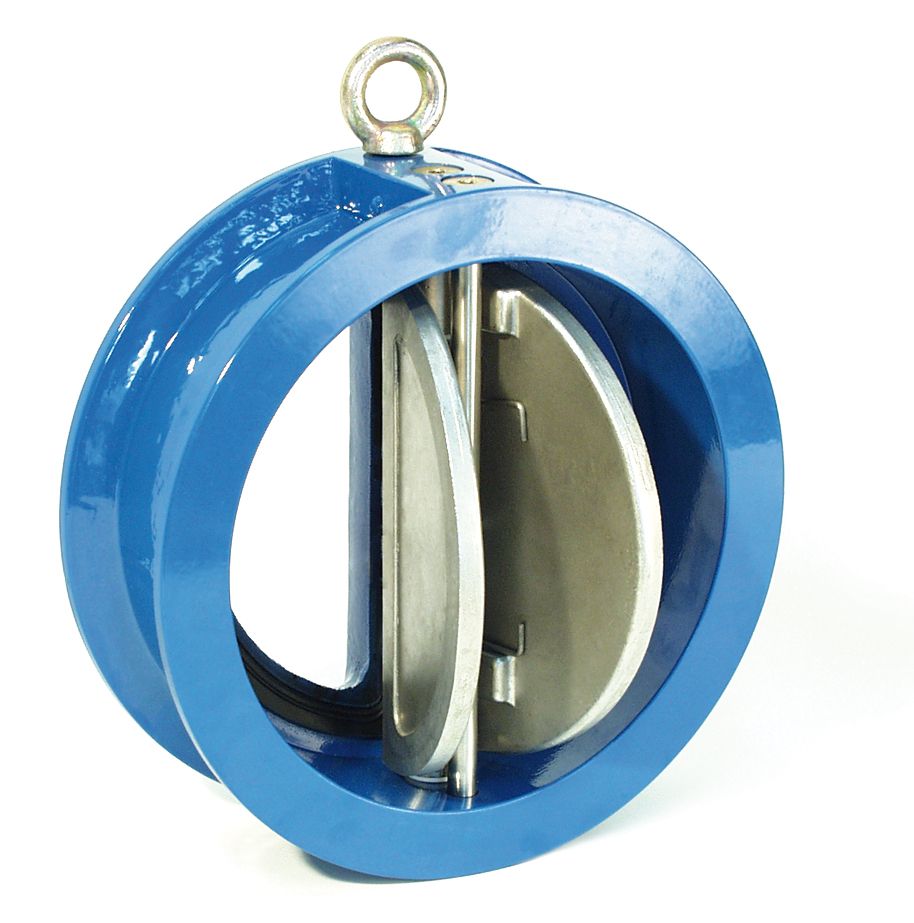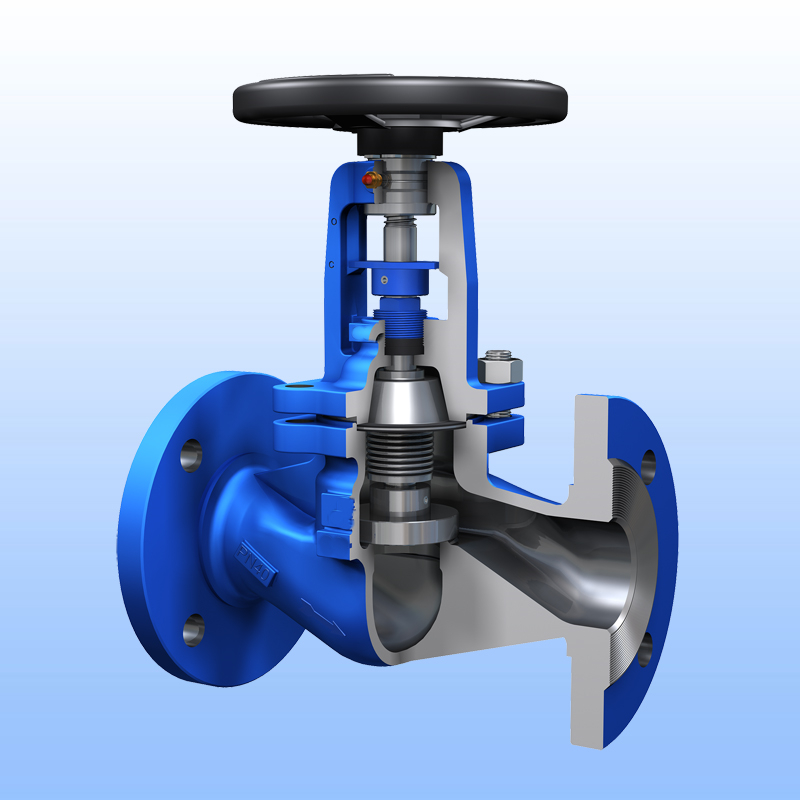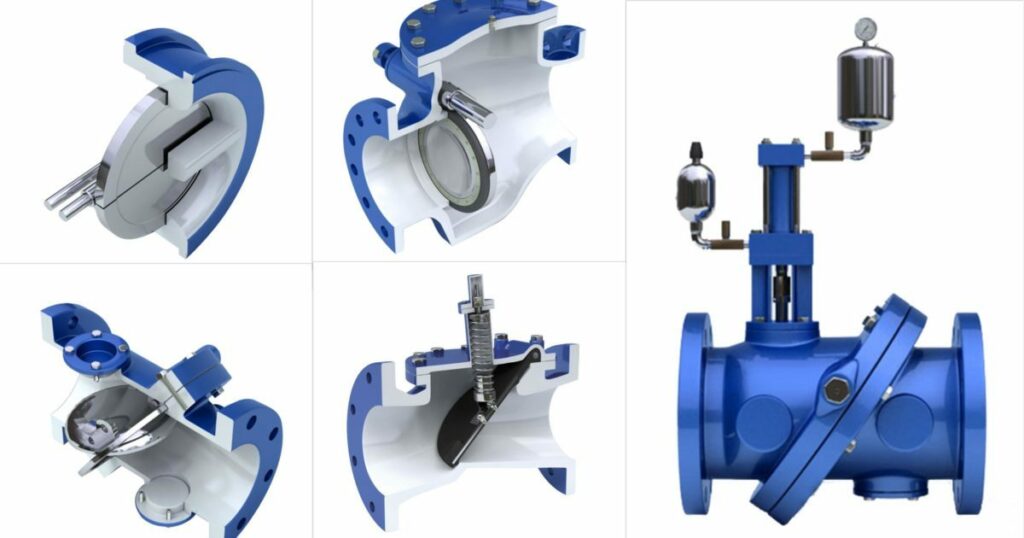Non return valves or NRVs are small, simple, and inexpensive sections whose main function is to allow fluid to only run in one direction. Non return valves are extremely popular and utilized within the industry. In different equipment and systems, you’ll definitely find NRVs. But do they look and function the same? No. There are different types of NRVs that not only look different but are used in different circumstances. We’ll introduce 6 of the most popular types of NRVs in this article with more information about their nature and usage. If you also want to learn more about different types of non return valve, keep reading this article with Linquip.
What are Non Return Valves?
There are a variety of types of non return valve, but their main function is similar at its core. Non return valves basically allow the flow to move in just one direction. As a result, they’re also known as one-way valves. NRVs are also considered a kind of two-port valve as they have two openings: One opening is for exiting and the other is for entering fluids. NRVs usually don’t require manual assistance and function automatically. So most NRVs don’t have stems or handles.
What are the Types of Non-Return Valve?
1. Lift Check Valve
Lift check valves are commonly used for high-pressure service and when the flow has a high speed. In these valves, the piston disc is precisely target-hunting by long contact and the thickness of the walls of the piston and dashpot are approximately equal. Big steam jackets are employed in the piston and on the exterior of the dashpot. This will prevent sticking out because of diverse enlargement. A lift check valve’s seat design can be compared to a globe valve. Usually, the disk is inside a ball or the type of piston. In vigorous fluid service, ball-lift checks are engaged. The top-notch leak-tight trait of these check valves is better than those of swing check valves.
2. Swing Check Valve
Once the disc in swing check valves shifts to entirely closed or entirely open status, it becomes unguided. There is a variety of different disc and seat designs that are usable for numerous situations. In comparison to metal-to-metal seating surfaces, soft-seated swing check valves are more leak-tight. To achieve higher leak-tight feature, seats are combined with a metal seat ring and resilient insert. As you may know, the seating angle is the angle between the vertical surface and the seat. This angle may vary from 0 to 45 degrees. The larger the seat angles get, disc movement gets more limited and closes quicker, hence loud noises are reduced, making them especially quiet among the types of non return valve.
3. Folding Disc Check Valves
Folding disk check valves are made in a wafer-body pattern at factories. These valves have soft or exhausting seats that are typically used in gas field services and low-pressure liquid. Its main characteristic is having a lightweight compact structure. This trait makes this valve extremely popular when convenience and acreage are needed. Folding disk check valves are also known as double-disc or split disc check valves.
4. Tilting Disc Check Valve
There are a number of flaws with the swing check valve that is fixed with the creation of the tilting disk check valve. This valve is particularly designed to be able to open completely. It can also be stable when the flow velocity is low and shut quickly when the forward flow is stopped. The disk of this valve floats within the flow and fluid runs on its top and bottom surfaces. This dome-shaped disk mechanism minimizes the dashpot impact. Among the types of non return valve, these valves are perfect for turbulent, pulsing, and high-speed flows. These features result in the valve’s lift prolonging and cutting back flow-induced dynamic masses on the piping system.
5. Stop Check Valve
Stop check valves are used either as an isolation (stop) valve which is a kind of a globe or gate valve or as a one-way check valve. Within the usual system operation, these valves are employed as a daily check valve. However, when needed, these valves can be closed by a screw-down stem. This stem is not mounted on the valve disc. When the stem gets entirely screwed down, it can hold the free-floating disc against the valve seat. This process happens even in a globe or a gate valve. These valves have different types including Wye-pattern, angle-pattern, tee-pattern, and inclined pattern. The swing-and-piston lift-disc style check valves are typically operated to stop check valves.
6. Vertical or In-Line Check Valve
Vertical or in-Line check valves are the types of non return valve that also come in 2 arrangements: In-line ball check valves are used in both horizontal and vertical lines. When used in horizontal lines, the totally guided disc inline check valves should have the help of a spring-assist closure. But when used in vertical lines, spring-assist closure may or may not be supplied. Not only is the spring-assist closure effective in closing the valve faster; it also prevents flow reversal and therefore minimizes loud noises. These valves can be used in pulsing flows such as a discharge line of a reciprocating compressor. Their size is compacted which makes them popular for small areas.
Why should we use different types of non return valve?
Although non return valves come in different shapes and sizes, they’re commonly inexpensive and small. NRVs defend pumps and compressor equipment from harm. These could be the result of reverse flow or backflow. Incompatible valves can cause production loss and downtime. These effects can be reduced with the help of NRVs. Other virtues of non return valves include saving energy and minimizing valve failure and maintenance costs. So it’s no surprise that non return valves are extremely popular in the industry.
Which type of NRV have you seen or used more? Are there any more NRVs that are missing from our list? Let us know in the comments below. Still, have more questions about types of non return valve? Simply Sign up at Linquip and ask us any questions or doubts you might have.
Buy Equipment or Ask for a Service
By using Linquip RFQ Service, you can expect to receive quotations from various suppliers across multiple industries and regions.
Click Here to Request a Quotation From Suppliers and Service Providers
Read More on Linquip
- Types of shut off valve: Your ultimate guide
- Types of plumbing valves: A complete guide
- Types of isolation valve: All you need to know!
- A Comprehensive Guide To Different Types Of Air Valves
- Types Of Solenoid Valves: Everything You Need To Know
- A Complete Tutorial To Learn About Different Types Of Check Valves
- Types of pressure relief Valve: All you need to know about PRVs
- Types of Water Valves: The Ultimate Guide
- Best Check Valve for Sump Pump: 9 of the Best Models
- 6 Different Shower Valve Types + Pictures: Your 101 Guide!
- Backflow Valve Installation, Costs and Maintenance
- How to Install a Thermostatic Mixing Valve? (Costs and Maintenance)
- How to Install a Water Pressure Reducing Valve? (Costs and Maintenance)
- Check Valve Installation Costs and Maintenance
- The 10 Best Water Shut off Valves
- What is Drain Valve? Working Principle, Types & Applications
- What are Coaxial Valves? Working Principles and Type
- What is Isolation Valve? Working Principle & Types
- 6 Types of Non Return Valve (Ultimate Guide)
- 6 Main Types of Plumbing Valves: Complete Guide







Interesting read thanks for sharing.
The non-return valve I’ll be using in my domestic reticulation system is the silent chech valve. The local municipal water supply in our community has a low discharge which results in rapid pressure drop in our household when two or more taps are open. My solution to partially remedy this situation is to add the NRV and a pressure tank positioned at a reasonable height to attain some substantial amount of head. The NRV will also prevent back flow.
Thanks for sharing your experience with us, Jacob! You can also visit our industrial directories, where you can find thousands of various industrial equipment based on your application and demand.